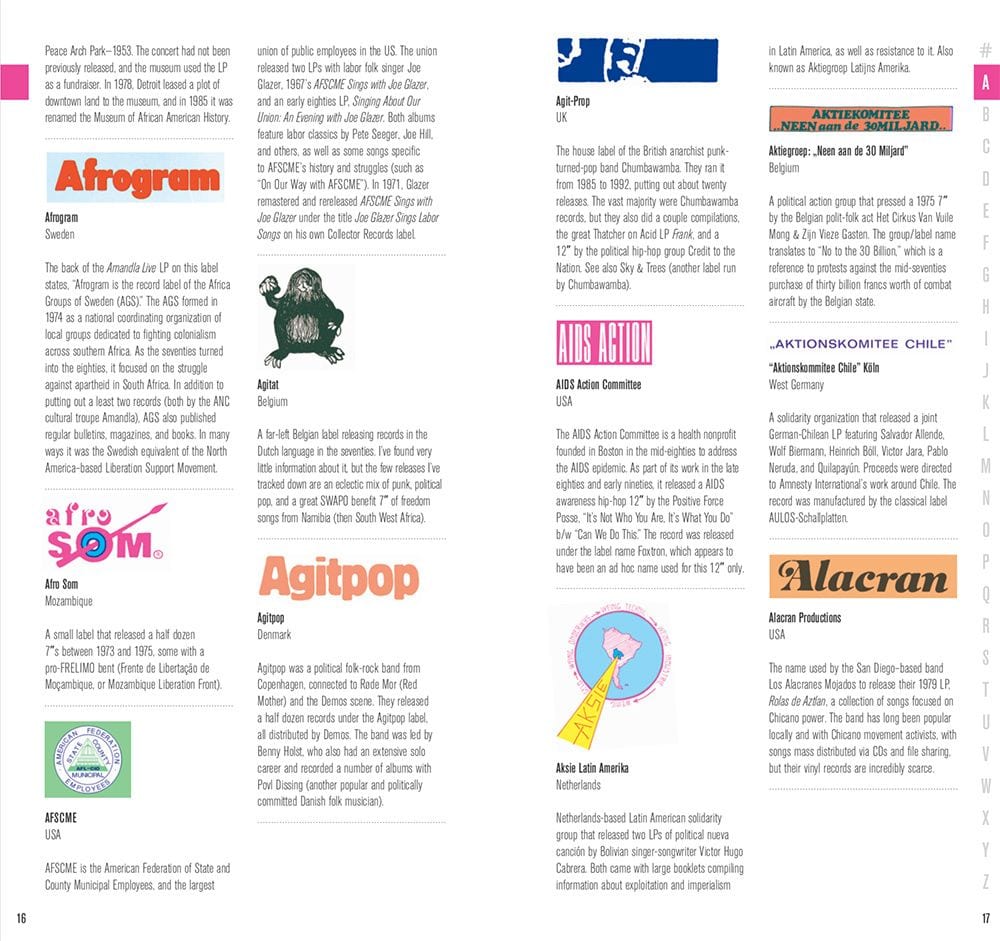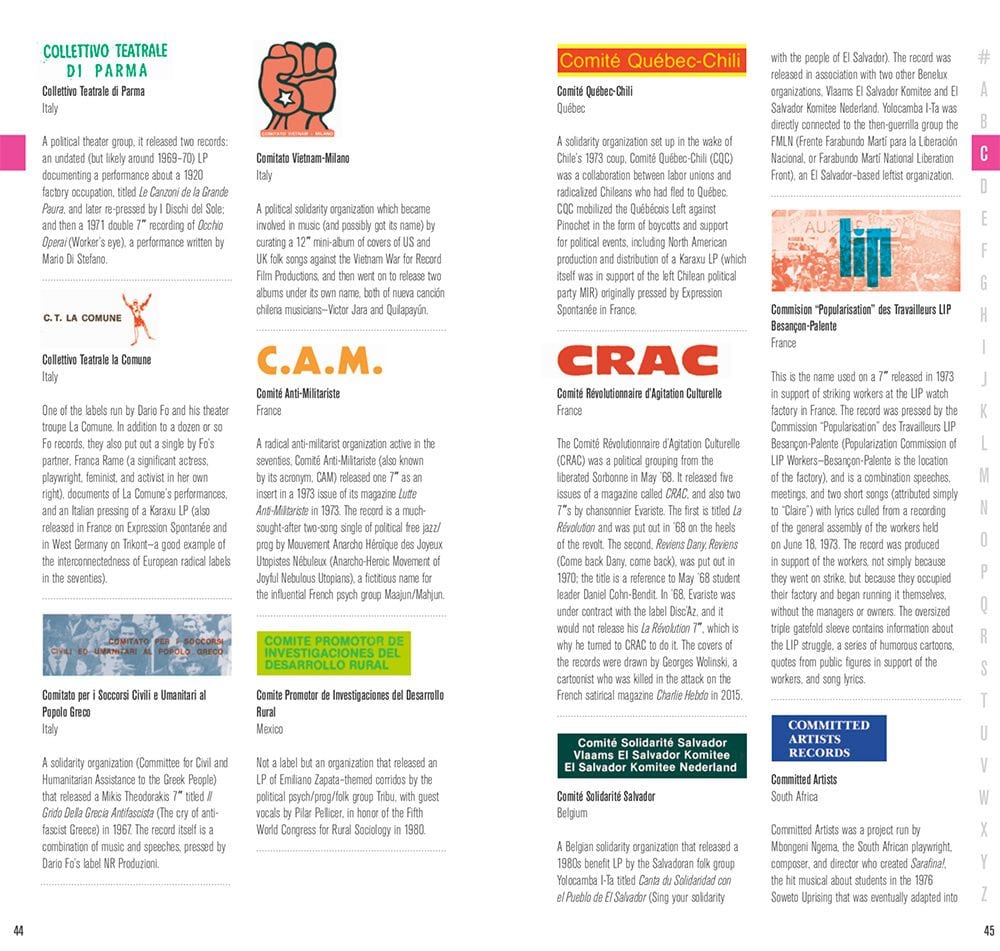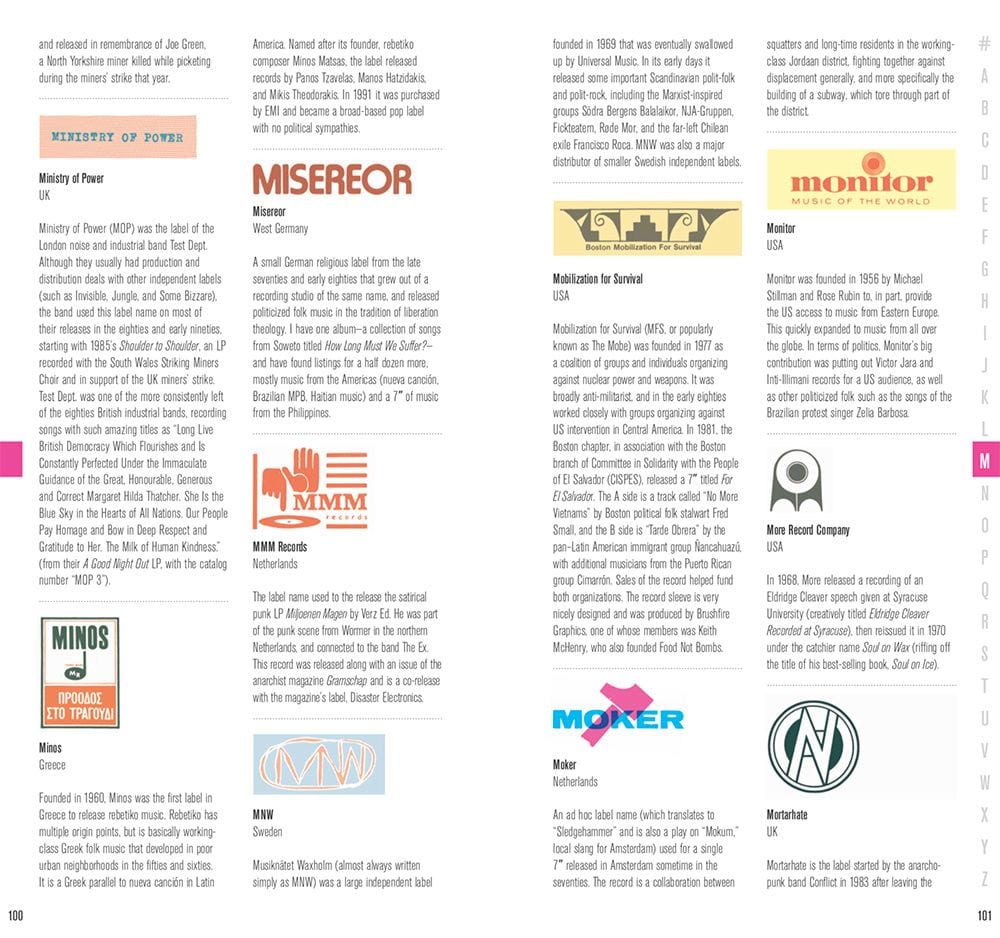
Encyclopedia
[…] While not intended to be read front to back, this book should still be interesting to read in chunks, where you can really start to see patterns and overlapping information. If you simply use it as a reference, you might not get to see just how many European Communist parties released records to support electoral campaigns, or how many labels across the globe released Chilean music as an act of solidarity after the fascist coup in the country in 1973. It is through this macro lens that some really compelling political ideas take shape, which is why the index (new to this edition) is so important. Give it a skim to see just how many people, movements, and ideas overlap and are connected to multiple labels.
Political
I’m profoundly interested in the roles that culture plays in social movements, and the actions of people organizing to transform their lives and their worlds. Until recently, most of that interest was channeled into the visual realm, studying political posters and graphics. (See Signs of Change: Social Movement Cultures 1960s to Now, AK Press, 2010, for more on this.) Researching the movements against the dictatorship in Chile and against apartheid in South Africa has given me a profound appreciation for the roles that music can play in social struggles. … [B]ecause this is ultimately a study of politics and social movements, you will find that much in here does not focus on music per se, but instead on field recordings, political speeches, and other forms of recorded sound. I’m not interested solely in music, but also in questions about who performs the sound, how it’s recorded, how it’s distributed, how it’s packaged, and who designs the packaging. That is why this book is a collection of “labels,” not musicians or recording artists. […]
[…] Technically, this is a compendium of labels that would all fall somewhere on the spectrum of “left.” I’ve actively excluded highly politicized and ideological recordings from the center and right. Believe me, they exist, and many are just as interesting as those included here from a musical, design, and materialist perspective (for example, see releases from the John Birch Society’s Key Records, or Detroit’s white supremacist Resistance Records—not to be confused with the two labels of the same name included in this book). But this project needed limits, and I’m most familiar with left movements and how they function, so keeping things reigned in by defining the politics this way made sense. In addition, while I might have kept out the Right, there is certainly no ideological consistency within this collection. It is extremely ecumenical: European anarchists rub shoulders with African nationalists, Latin American communists share pages with militant defenders of minority languages and suppressed nationalities. I also in no way support much of the politics here. I am no more excited by the homophobia of some of the early Black nationalist records than I am by the Stalinism of some of the New Communist parties that emerged in the seventies. But outside of some extreme examples (for instance, I have excluded the Rassemblement du Peuple Togolais—a political party that ruled Togo for over forty years, which released a number of cool records with the word “revolutionary” in the title—because although loudly anti-imperialist, it was also brutally antidemocratic and anti-communist), I’ve largely included labels and groups because they self-defined as part of a progressive political project, be that socialist, communist, or nationalist.
[…]
I initially gravitated towards recordings released by anarchist, socialist, and communist outfits, but this encyclopedia also articulates a lot about the intersection of music, sound recordings, and nationalism, although I didn’t start out with this intention. While much of the scholarship on the development of modern nationalist movements focuses on print culture (for example, see Benedict Anderson’s writing), one can glean from the entries included here that audio recording and the vinyl record have also been important components of preserving and articulating nationalism. A couple dozen labels included here focus specifically on minority linguistic and cultural groups fighting for sovereignty within larger national states. Armenian, Basque, Breton, Catalan, Corsican, Gaelic, and Welsh all make appearances, never mind unique dialects of larger language groups. In addition, some of the labels represent identity groups that transcend current borders (for instance Berbers), as well as those that are fighting for their traditional territories and homelands, such as Catholics in Northern Ireland, the Québécois, Palestinians, and various groups in the Western Sahara.
[…]
So what this project documents is a product of the uneven access to pressing plants, or even record players, across different regions of the globe. Most of South America decolonized in the nineteenth century, and developed a robust middle-class in the period after WWII; as a result, during the heyday of vinyl people there had access to both vinyl production and the means to distribute, purchase, and listen to the records. In comparison, most of Africa didn’t decolonize until the late 1950s and early sixties, and then much of southern and Portuguese Africa not until the seventies. After independence, very few of these countries had vinyl pressing plants, and if they did, it was based on the whims of the previous colonial power.
[…]
The Caribbean presents another situation where the majority of music lovers—be it of reggae, soca, calypso, or steel bands—were extremely poor and likely didn’t have record players. But they did have transistor radios, which they listened
to extensively. So any musician who wanted to bring their music to the people had to press records, and then get them into the hands of popular radio DJs. Ideally, records would then also end up in the collections of the people who ran the local sound systems—mobile collectives of DJs, sound techs, and “toasters” (MCs) who rove around ghettos on trucks loaded up with massive stacks of speakers. These two forms of consuming music collectively meant that there was little need for individual record ownership.
By contrast, in East Asia the dominant form of political musical production was from above, with centralized state record labels producing music and recordings in direct support of their regimes. The Chinese Communist Party founded China Records (Zhongguo Changpian) in 1954, only five years after taking power, and by the mid-sixties had put out hundreds of records for both internal use and export. Their Vietnamese and Laotian Communist Party counterparts (which created the Dihavina and Dislaohaksat labels, respectively) inherited countries without pressing plants (the pressing plant in Vietnam was in the south, so the Communists couldn’t access it until after they won the war), so they had to turn to the Soviet block to get records made; in addition, a much smaller proportion of their populations had access to record players.
[…]
Non-nationalist minority identity also fueled record production. The feminist and lesbian movements in particular vigorously took up the form of the vinyl record. Not only did most of the broad left labels from around the world (see Demos, Expression Spontanée, Plateselskapet Mai) release records dedicated to feminist and/ or lesbian folk and pop music, but many individual musicians and small communities of artists created their own labels (Carolsdatter, Hexensaite, Index). Lesbians in the US even created their own distribution system for records, with Olivia Records acting as a clearinghouse for a number of smaller lesbian-focused labels. Interestingly, I’ve found no parallel to this amongst the gay male community, and although AIDS activism created one of the most impactful social movements of the twentieth century, it is strangely absent in the cosmology of the vinyl record.
[…]

Record
For this project, “record” is defined as a vinyl record. During the second half of the twentieth century, this object played an outsized role in the life of recorded sound: it was the primary form of both its distribution and commodification. While shellac and then early vinyl records in 16 and 78 rpm formats had existed since the 1880s, it wasn’t until the late 1950s and early sixties that the 12′′ long-playing albums and 7′′ “singles” we recognize today came to dominate the music market. In the early 1930s, both RCA Victor and Columbia Records introduced 331/3 rpm vinyl records; RCA Victor’s version was 12′′ in diameter (or, to be more exact, thirty centimeters), while Columbia’s version was 10′′ in diameter. But these experiments crashed with the economy during the Great Depression. Then in 1948, Columbia introduced the contemporary 331/3 rpm 12′′ record. In 1949, RCA Victor released the 45 rpm 7′′ in competition; while this format spun faster and thus held less music than Columbia’s format, RCA Victor bet that the eventual development of technology to enable the automatic playing of multiple records in a row would obviate the need for consumers to get up and change the records themselves. By 1956, the two systems would almost completely control the recorded music market, with the 12′′ for albums and the 7′′ for singles.
The significant crossover between recorded music and political movements begins with the Civil Rights Movement in the United States. The movement was extremely savvy with its use of emerging communication technologies, staging some of the first actions to be captured by news crews and broadcast live on television. The movement also took full advantage of the vinyl record. The Congress of Racial Equality released Sit-In Songs: Songs of the Freedom Riders in 1962. The Student Nonviolent Coordinating Committee’s Freedom Singers quickly followed, releasing their first single and album—both titled We Shall Overcome—in 1963. Over two dozen recordings of Martin Luther King, Jr. were released on vinyl in the sixties. Even
major labels got in on the act, with Mercury, Motown, Atlantic, and Buddah releasing Civil Rights Movement LPs. Folkways Records released field recordings of people marching, singing, and giving speeches at demonstrations. While Alan Lomax had been making invaluable recordings and eventually vinyl records of African American religious, labor, and prison songs, they feel like anthropological documents of a culture being subsumed by modern ways of life. In contrast, these movement records felt like just that, movement—they were documents of people in transition and struggle, and made the listener feel like they were there. Buying the records was a way to support the movement, and spread its message.
While the rise of the vinyl record tracks neatly with the explosion of the Civil Rights Movement, by an odd turn of history, the end of its heyday is roughly 1990—the year that Nelson Mandela is released from prison in South Africa, marking the turning point in the last of the great political struggles of the twentieth century. Just as the format of the vinyl phonograph record is eclipsed by the compact disc, we see the end of a twenty-year-plus flow of recordings focused on ending apartheid, crushing colonialism in southern Africa, and securing Mandela’s release.
[…]

Labels
Like every other term in this book’s title, I’m also being loose with “label.” While many of the entries in this book concern professional entities organized for the purpose of producing vinyl records, many do not. I’ve purposely stretched the term “label” to include citizen’s initiatives, labor unions, theaters, churches, and political parties that released records (as well as musical groups that self-released their records). I find this broad engagement with record production and distribution quite compelling.
[…]
When I started this project, I was also interested in the intersection of music, politics, and design. One of the things that initially sparked my imagination was looking at the variety of logos and icons that different labels used, some riffing off common musical or political themes (vinyl record shapes, fists, peace doves, etc.); some entirely generic, as if their makers were still finding their ideological leanings; still others excitingly weird (see the mascot for Belgium’s Agitat label).
As work on this book has progressed, I’ve been less and less focused on the graphics, and more on collecting and distilling the information and history. But the logos are still a very important part of this project, and hopefully for you, the reader, a very enjoyable one. I’ve been able to produce them in color in this edition, so they can really shine. Other than a very small number of examples where actual records were impossible for me to find, all the logos here have been photographed or scanned directly from the records and their sleeves (either by myself or friends). I’ve gotten a little creative with some of the icons, especially when labels themselves didn’t appear to have a logo beyond their name displayed in a standard font, even as their covers were rich with imagery. In other words, some of these might not be “official” logos, but they all are derived from the records in one way or another.

Conclusion
[…]
Whether it’s rooted in nostalgia, a need for something material to come with one’s consumption, or a real desire to hear the physicality of music crackling off a needle and through speakers, there is no question that vinyl has returned. Sales of vinyl records continue to rise, with 16.8 million LPs sold in the US in 2018, up 14.6 percent compared to 2017, and a massive 94.6 percent compared to 2006. Because the major labels forcibly closed so many pressing plants in the nineties, there is now a huge backlog for pressing vinyl at the remaining plants and at new boutique ones that have started in the past decade. It is not uncommon for a small band or label to have to wait six months to have a record pressed.
Vinyl records have also returned to bookstores—you can now buy a copy of Black Sabbath’s Master of Reality at Barnes and Noble. Vinyl has even begun showing up at Whole Foods. But the strangest new development is the return of the “record club.” Well over a dozen vinyl subscription services have started up over the past couple years, one of the most popular being Vinyl Me, Please. An evolution of the record and tape clubs of old, here you sign up and have a new vinyl record sent to you every month. These are a mix of old and new recordings; most are lavishly packaged in gatefold sleeves, with colored vinyl, and other “unique to the club” perks. But the strangest thing about almost all these clubs is that you have no control over the content of the records, so one month you get a re-press of a classic prog rock album, and the next you get the new Taylor Swift LP.
All of this is to say, while vinyl has returned, it feels strangely hollow without a concomitant connection to movements, unions, community groups, and music acts that privilege content over stardom. I hope this little love letter to the potentials of the vinyl record can help reconnect it to its roots as a key tool in the Civil Rights Movement—a medium for improving our communities and world, not simply our personal consumption and listening experiences.

Josh MacPhee is a designer, artist, and archivist. He is a founding member of both the Justseeds Artists’ Cooperative and Interference Archive, a public collection of cultural materials produced by social movements based in Brooklyn, NY (InterferenceArchive.org). MacPhee is the author and editor of numerous publications, including Signs of Change: Social Movement Cultures 1960s to Now and Signal: A Journal of International Political Graphics and Culture. He has organized the Celebrate People’s History poster series since 1998 and has been designing book covers for many publishers for the past decade (AntumbraDesign.org).
Excerpted in parts from An Encyclopedia of Political Record Labels, by Josh MacPhee. Copyright © 2019 Common Notions. Excerpted by permission of Common Notions. All rights reserved. No part of this excerpt may be reproduced or reprinted without permission in writing from the publisher.

